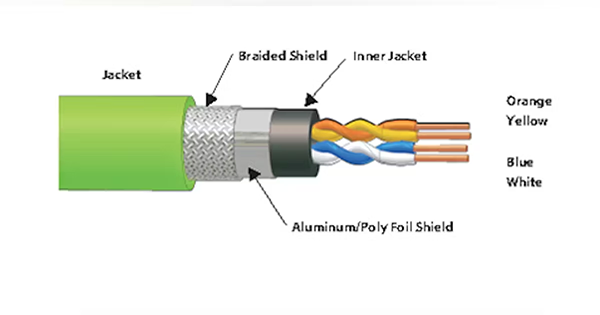The major cyberattacks mostly happen due to a lack of human mismanagements and not prioritizing the establishment of security metrics.
Picture a big factory floor with one astonishing cable emerging as the unsung champion, the undercover guardian against the digital menace. For the record, this is not a far-fetched science fiction premise anymore.
As factories become smarter and digitally connected, they are, in turn, becoming more vulnerable. The systems that bring so much efficiency and excellence can also provide a path to some pretty nasty consequences.
These rugged, reliable workhorses are much more than just wires – they are now the first line of defense. As an internet analyst who has studied the topic of industrial ethernet cable for a while, I’ve realized that they are no longer considered a commodity; it’s now the critical backbone of a cyber-secure manufacturing future.
Through this blog post, I’m going to provide numerous details regarding this seemingly unassuming component, giving a glimpse of a new gen innovation to the readers.
Let’s begin!
Key Takeaways
- Understanding why smart factories need stronger cybersecurity
- Looking at the hidden role of Ethernet cables in modern manufacturing
- Discovering their complete evolution in cyber defense
- Decoding what makes them different from other cables
- Uncovering how its secure spectrum protects the productive workflow
According to me, everything in the software and hardware spectrum, whether you talk about innovations or the emergence of new threats in it, evolution has impacted both the boon and the bane. A cyber attack can stop a production line, cause damage to valuable machinery, and affect the quality and safety of products.
A stronger approach to cybersecurity is the best opportunity that helps a smart factory be innovative and successful, without the fear of having the technology and resources exploit the factory, destroying value and efficiency instead of producing it.
Interesting Facts
Over 75% of recipients in a 2023 survey concluded that facing a supply chain attack, highlighting the interconnected risks.
(Source)
In my opinion, the role of Ethernet cables is more diverse and impactful than it seems, as modern production is becoming more resilient; they are ones that support the necessary advancements in the algorithms.
These are the silent central nervous systems of a modern factory made with extensive materials like thermoplastic polyurethane (TPU), delivering signals essential to coordinate everything. They make connections between sensors to controllers, and machines to managers to ensure the data flow is being delivered to where it’s needed.

As you can see, this infographic above shows the demography of Ethernet cables that makes it different from the conventional ones.
If you ask me about the domain of cyber defense, I’d say that it has become very vast and stuffed with numerous technological utilities. However, as factories were networked together, the demand for cables with characteristics that could resist extreme temperatures, continuous flexing, and electrical noise began to grow.
The evolutionary process continues now into the area of security. Modern specialized cables feature shielded cables that act as a first line of defense, helping to block external cyber risks from tapping into the network, realizing the total operation from the physical layer upward.
Well, this is the most interesting segment of this topic because many are unaware of the complete utility and its immersive benefits. Even if they appear similar, industrial Ethernet cables are designed to survive in a tougher environment.
They have an indestructible shielding to protect against electrical noise caused by robust machinery, tougher jackets to protect against oil, chemicals, and abrasion, and more effective construction to withstand continuous vibration and extreme temperatures.
Last but not least, I will talk about the connectivity that protects the productivity and efficiency of the factory units because they are prevalent nowadays. Modern manufacturing is all about productivity and security, and secure connections are the hidden force behind all of that.
A secure connection means the readings from a sensor are trusted, a robot moves with precision without interruption, and production information remains trustworthy and uncorrupted. Due to this, all the vulnerabilities in the hardware get contaminated, and you will get a system that is better than ever before.
To sum up this entire segment, I just want to say that this hyper-connected environment requires new security, which is predictive and adaptive, integrating into the fabric of the network itself. We are heading in the direction of systems that will automatically detect anomalies, contain threats immediately, and self-heal independently of human involvement.
Make sure to read this article carefully to understand that they are not only extensive but also smarter algorithms that can self-protect on their own and safeguard the valuable processes they support in an increasingly intricate digital environment.
The major cyberattacks mostly happen due to a lack of human mismanagements and not prioritizing the establishment of security metrics.
Five primary types of cybersecurity are Network Security, Application Security, Information Security (InfoSec), Cloud Security, and Endpoint Security.
While there is no single best country in the world in terms of cybersecurity, if you look at the stats, the United States has the most prominent rank in this spectrum.
